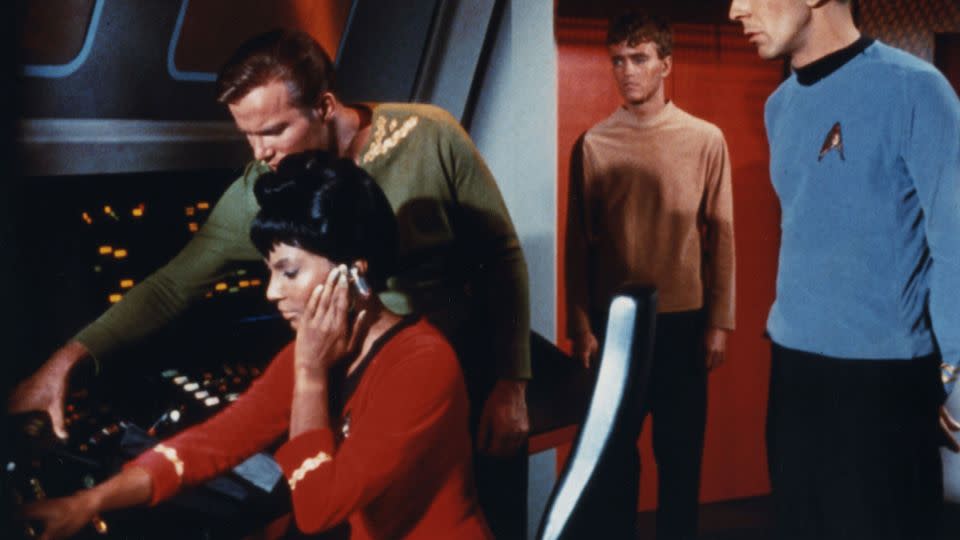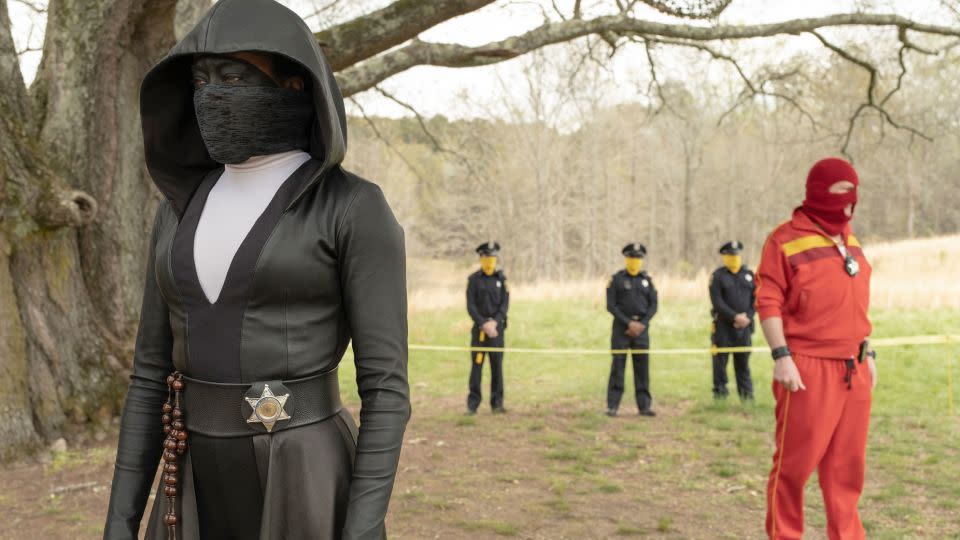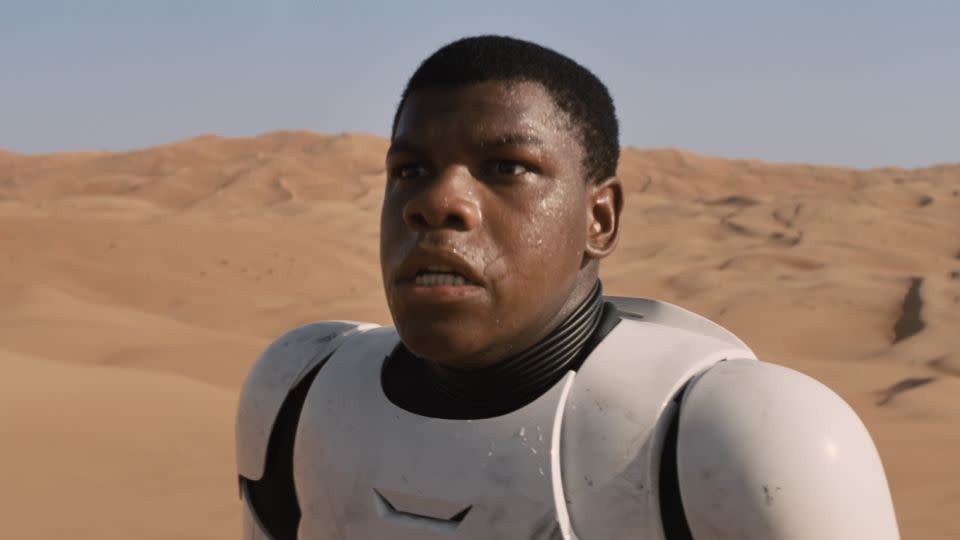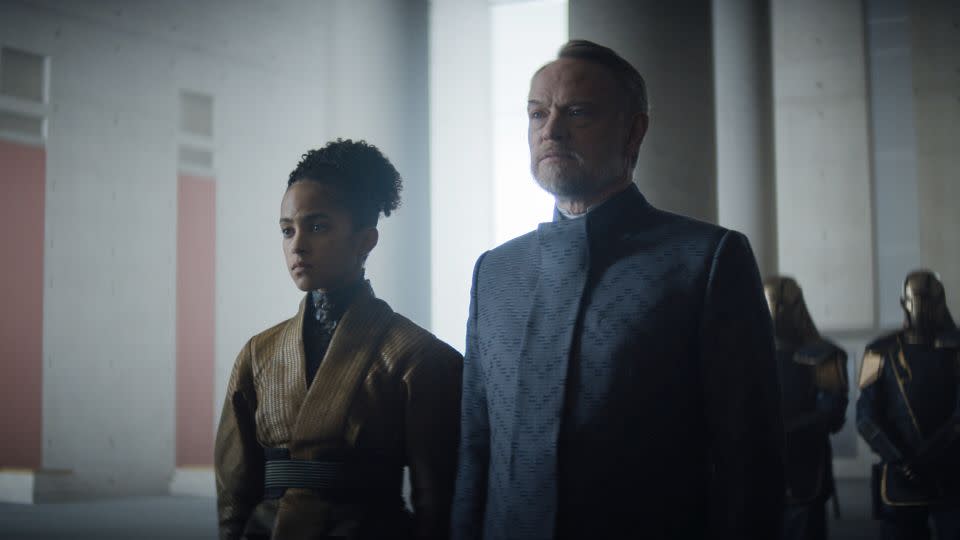Black characters and stories are finally in the sci-fi and horror spotlight. It’s been a long time coming for fans
- Oops!Something went wrong.Please try again later.
- Oops!Something went wrong.Please try again later.
- Oops!Something went wrong.Please try again later.
Editor’s Note: The next episode of the CNN Original Series “See It Loud: The History of Black Television” explores the role of Black voices in the realm of horror, superheroes and science fiction. It airs Sunday, August 6, at 9 p.m. ET.
Science-fiction author N.K. Jemisin loved “The Jetsons” as a child, fantasizing about taking a flying car to school thanks to its space-age vision of the 21st century. But while watching reruns as an adult, she noticed that there was “nobody even slightly brown” and that “even the family android sounds white” in a show meant to envision the future.
“Thing is, not-white-people make up most of the world’s population, now as well as back in the Sixties when the show was created,” Jemisin wrote in a 2013 essay. “So what happened to all those people, in the minds of this show’s creators?”
It’s a question many have asked about science fiction, a genre that some laud for its progressive imaginings and portrayals of the future, but others have called out for minimizing or erasing people of color — across literature, television and film.
Genres like Afrofuturism have fused sci-fi elements with Black and African culture, the science fiction and fantasy writings of Jemisin and Octavia Butler are highly regarded, and beloved characters like Uhura on “Star Trek” have left a lasting mark on popular culture. However, sci-fi and adjacent categories like horror have often focused on White protagonists and their experiences, and Black audiences have historically been disregarded by mainstream projects.
In recent years, the success of films like “Get Out” and “Black Panther,” as well as TV series like HBO’s “Watchmen,” has shown that there’s a hunger for Black stories in sci-fi and horror — and that those narratives have mass appeal. This success and the Black sci-fi and horror titles that have followed also prove that Black fans of these genres — who have long wanted to see such stories onscreen — have been here all along.
A brief history of on-screen representation
Early sci-fi films like 1936’s serialized “Flash Gordon” and TV shows like the original “Lost in Space” (1965-1968) were known for their out-of-this-world depictions of the future. But like “The Jetsons,” they centered on White protagonists with nary a Black character in sight. (“Flash Gordon” villain Ming the Merciless — portrayed by a White actor — is now considered a racist stereotype inspired by “Yellow Peril” ideology.)
When Black characters did appear, it was “usually to make a point about race or otherness. It reflected this concept of not looking at Black people as people and as a part of broader humanity,” said Ytasha L. Womack, author of “Afrofuturism: The World of Black Sci-Fi and Fantasy Culture” in CNN Original Series “See It Loud.”
The mid-to-late ‘60s signaled a shift with Eartha Kitt taking over as Catwoman on TV’s live-action “Batman” and Nichelle Nichols as Lt. Nyota Uhura on “Star Trek” — a role viewed as groundbreaking to this day. The “Star Trek” franchise would go on to feature Whoopi Goldberg, LeVar Burton and Avery Brooks in memorable roles during the ‘80s and ‘90s. While “Star Trek” is often applauded for diverse casts and for some powerful statements around race, some viewers have called out real-world stereotypes in certain depictions of fictional species.
Newer “Star Trek” shows such as “Discovery,” with Sonequa Martin-Green as the franchise’s first Black female lead, feature “fully raced characters and break with accepted ‘Star Trek’ canon in interesting ways,” said Isiah Lavender III, Sterling Goodman Professor of English at the University of Georgia, who specializes in race and ethnicity in science fiction.

However, there are other areas where science fiction faces questions around its treatment of race.
“Science fiction deeply overlaps with race and racism with its aliens, artificial people and scenarios,” Lavender said in an email. “Why is the creator of Skynet in the ‘Terminator’ franchise a Black geek, but the human resistance leaders are White, the heroine is White and the terminator itself White?”
Meanwhile, in horror films, Black characters are often the ones who are killed off first. The trope is so common, it inspired the tag line for this year’s horror-comedy, “The Blackening” — “We can’t all die first.”
It’s the kind of recurring plot point one may not think much about initially, and such clichés can become easy to normalize through jokes, said Juju Green, who posts movie commentary to more than 3 million TikTok followers. But when viewers watch something that subverts such narratives, it can make an impression — and cause them to seek TV and movies with a fresher approach.
“Deep Blue Sea,” which Green described as “an awful movie” but “still a classic in its own right” was the first time he saw a Black character (played by LL Cool J) survive a sci-fi horror film.
“That was one of the first times where I said, ‘That could happen?” he recalled, while acknowledging that Samuel L. Jackson’s character in the 1999 film “infamously” did not make it. “I thought that was really really cool.”
Black sci-fi and horror take off
“Black Panther,” “Get Out” and shows like “Watchmen,” which put the spotlight on the Tulsa race massacre, a tragic and long unacknowledged piece of Black history, are by no means the first examples of Black sci-fi and horror to hit our screens. But released within close proximity of each other between 2017 and 2019, they got people talking — and in the case of the films, saw some big box office numbers — indicating that Black storylines could speak to a wide audience.

Since then, viewers have seen the release of series like “Lovecraft Country,” “The Underground Railroad” and “Swarm.” The Marvel Disney+ series “The Falcon and the Winter Soldier” delved into issues surrounding race in the United States. Jordan Peele’s “Us” and “Nope” were highly anticipated ahead of their respective theatrical releases. This year, films like “The Blackening” and “They Cloned Tyrone” are prime examples of genre fare that highlight very specific Black cultural experiences. What began as a “trickle,” has led to “heavy-hitting Black stories amongst this layer of sci-fi and horror,” Green said.
“Whether or not this is true, I think part of it may have been studios feeling pressure especially during and after the summer of 2020 to put their money where their mouths were when it came to supporting non-White media. But ignoring the fact that shifts were happening long before that would be a disservice to those creators,” said Nic Sam, a writer for the LGBTQIA+ pop culture site Autostraddle. She noted that Black Panther made his comic debut in 1966, while Octavia Butler’s writings covered a range of sci-fi, fantasy and horror.
“We’ve always been here,” Sam wrote in an email. “The wider (and whiter) audience just hasn’t always seen us, so I’m thrilled that’s starting to change.”
Sci-fi and fantasy aren’t just for White audiences
There has been some pushback as sci-fi, fantasy and horror storylines diversify — as seen in social media backlash to non-White actors who were cast in recent “Star Wars” installments, “Lord of the Rings” adaptations and more.
“That upset a segment of American society,” said Lavender, while recalling the casting of John Boyega as Finn, a Black stormtrooper in 2015’s “The Force Awakens.” “Why in this fantastical universe with myriad planets and intelligent species, would there not be a Black stormtrooper, is the question?”

Green pointed to one complaint he heard about White characters being outnumbered in this year’s animated “Spider-Man: Across the Spider-Verse.”
“They’re used to seeing themselves represented on-screen and now that we’re in a position of, everyone’s being represented on-screen, they start to feel a little less ‘represented,’” he said of such critics. “And there’s an air of being threatened by that. There’s a layer of them thinking that they’re being pushed out.”
This kind of thinking, coupled with the prominence of White characters and storylines in earlier mainstream horror and sci-fi titles, has led to a misconception among some that Black audiences aren’t — or shouldn’t be — interested in those genres.
Sam said she has been “treated differently” for enjoying “nerdy entertainment” in the past, while Green said his love of anime and comic books was what some people would call “White people sh*t.” But they’re not alone in their interests either.
“I remember when I discovered the word ‘Blerd,’ a shorthand for Black nerd, and it was like a new world opened up for me where I could unapologetically go on about the (Marvel Cinematic Universe) or ‘Nope’ theories or the beauty of Wakanda without needing to explain why it mattered,” said Sam. “There can be a lot of toxicity in internet fandom, but I’m so grateful for platforms like Twitter and TikTok because they’ve opened my eyes to just how many of ‘us’ there are.”
Looking to the future of sci-fi and horror
Excited by many of the series and movies released in recent years, Lavender, Green and Sam are all eager to see what could come next as sci-fi and horror storytelling evolve with more creators of color at the helm.
Lavender, who finds Apple TV+’s “Foundation” adaptation “interesting because of its projection of BIPOC characters that aren’t really in the novels” by Isaac Asimov, said he wants “to see strong adaptations and original works in all speculative mediums written by all people.”

Sam started out as more of a sci-fi and fantasy fan but has been paying attention to more horror in recent years, largely due to “the more mainstream emergence of Black horror creators.”
“I do think it’s a perfect genre with which to explore the very real fears of simply existing as a Black person in a world where that is a radical act,” she said. “But I do genuinely believe there’s space for the examination of racism through genre and also for Black folks to just have a scary old ghostly time!”
She ultimately wants to see a variety of storytelling in the years to come.
“I want deep intellectual genre storytelling; I want campy horror that makes fun of itself; I want terrifying ghost stories,” she said. “What I hope is that (the creators) who are putting in that work get the chance to showcase it in massive ways because the audience has already proven they exist.”
CNN shares parent company Warner Bros. Discovery with HBO, which is behind series like “Watchmen” and “Lovecraft Country.”
For more CNN news and newsletters create an account at CNN.com

